INTRODUCTION
This article is a research paper on the variant ship design of an amphibious landing support vessel of a navy in support of marine landing operation on a hostile shore. Various ship designs were considered of this type of vessel to show the development from the old LST model to a modern Amphibious Landing Dock vessel. The following narratives illustrate the origin of said type of vessel to what it is known today as a fully perfected and developed landing ship dock (LSD) in the inventory of various navies listed in the Janes Fighting Ship.
FIRST GENERATION LANDING SHIP TANK (LST)
Shown in Fig. 1 is a model of a landing ship tank of a foreign Navy.
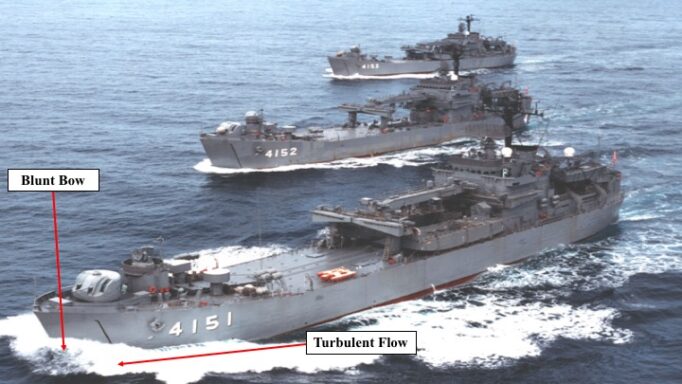
Fig. 1
It was observed that the bow wave turbulence is pronounced ahead of the bow which would indicate that the vessel has a blunt bow. A wave creates that massive turbulence ahead and affects the efficiency and speed of advance of said vessel. Excessive hull resistance as shown in Fig. 1 manifests tremendous hull resistance which results in fuel higher consumption, and excessive stress to the main propulsion system. The maximum attainable sustained speed is approx. 13 knots.
SECOND GENERATION OF LST: LANDING SHIP DOCK
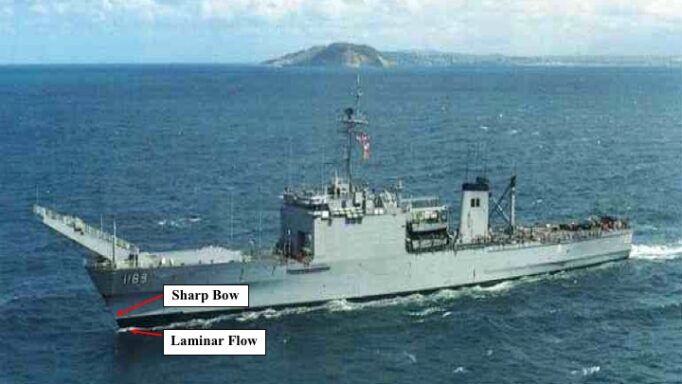
Fig. 2
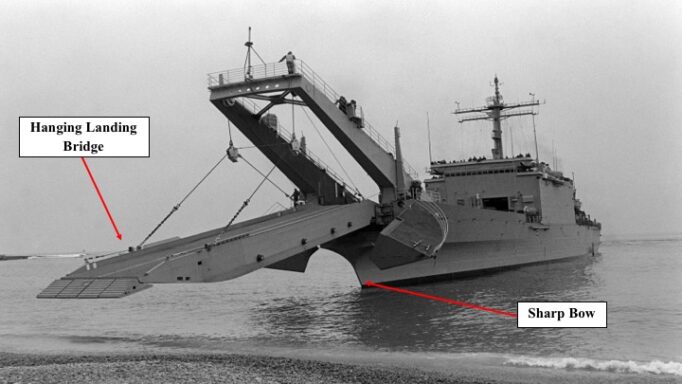
Fig. 3
To achieve a sustained speed of 20 knots, the traditional blunt bow and bow doors of the original LST design (Fig. 1) were replaced by a pointed or sharp bow (Fig. 3). Unloading is accomplished through the twin derrick at the deck and a ramp operated over the bow. The stern gate to the tank deck permits unloading of LVT into the water or unloading of other vehicles into a Landing Craft Utility (LCU). The sharp bow (Fig. 3) reduces excessive resistance because the bow slices through the water with laminar flow instead of turbulent flow as indicated in the first generation landing ship tank in Fig. 1.
THIRD GENERATION OF LST: LANDING SHIP DOCK
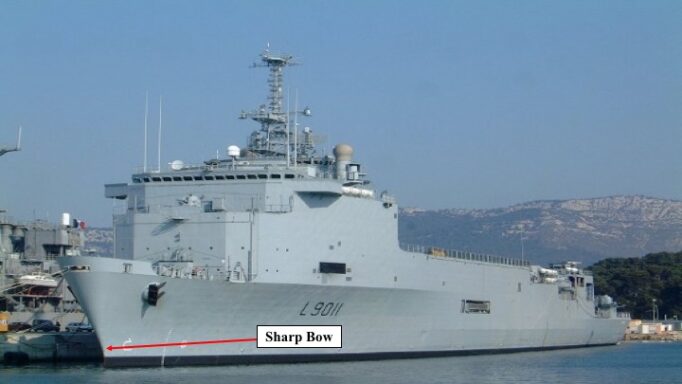
Fig. 4

Fig. 5
The third generation LST became LSD (Fig. 4) with a sharp bow and stern door, and can cruise in the water in a sustained speed of 21 knots with low fuel consumption and less stress to the engine with proportionate speed of advance in terms of speed and power of said vessel. This type of vessel is already in various modern navies since it is capable of conducting swift and silent amphibious landing operations in a hostile shore through the stern after door (Fig. 5).
DIAGRAM OF THE DIFFERENCE OF LAMINAR FLOW AND TURBULENT FLOW OF WATER AROUND THE HULL
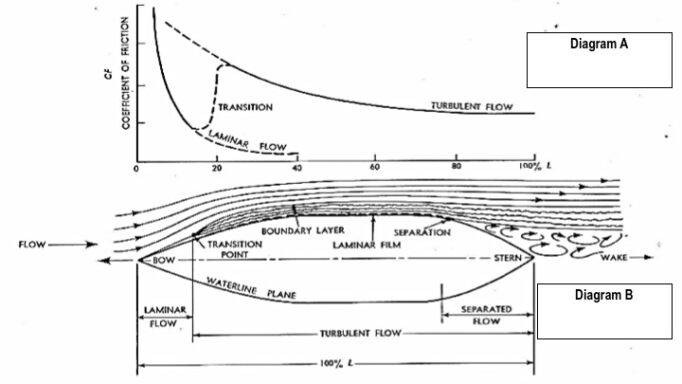
Fig. 6
The resistance diagram (Fig. 6), shows turbulent flow at the bow is greater in a blunt bow which can greatly affect the speed of advance of a vessel with greater fuel consumption and not proportional to the speed of advance. Whereas, a sharp bow has a laminar flow that slices through the water proportionate to the speed of advance with proportionate fuel and power usage per nautical run, making it a better bow.
Fig. 6 shows the coefficient of friction versus the length water line of the ship hull, a vessel with a sharp bow presents laminar flow at the boundary layer slicing the water with less friction resistance at 20% of the length waterline. At this point, turbulence flow occurs as the sharp bow slices through the water instead of pushing the water with greater frictional resistance as presented in Fig. 1.
AMPHIBIOUS SUPPORT VESSEL OF THE NAVY
The newly acquired Amphibious Support Vessel of the NAVY called the SSV is capable of achieving an approx. sustained speed of about 13 knots. It is suspect as shown in the Fig. 1 example of characteristics of a blunt bow. It should rather be in characteristic and behavior of a pointed or sharp bow (Fig. 7) to improve speed to approx. 20 knots.

Fig. 7
CONCLUSION
The blunt bow can negatively impact higher life cycle cost in terms of fuel consumption, stress to the main engine and excessive hull vibration, affect the efficiency of the crew, as well as wear and tear of some sensitive electronic equipment on board. Moreover, It is the origin of acoustic signature that can attract homing torpedoes and mines with an acoustic guidance system susceptible to a home run to the hull, or trigger a sea mine on the ship.
RECOMMENDATION
The Navy should be prudent, perform due diligence, and understand the performance of an SSV vessel with a blunt bow. It must also consider the seakeeping characteristic which is very critical to a seagoing Navy in terms of life cycle cost, susceptibility, and efficiency of the ship system in order to meet the expectations of the tax paying citizens.
About the Researcher:
CAPT TOMAS D BAINO PN (Ret) served the Philippine Navy Naval Shipyard and has undergone ship hydrodynamics orientation at the Defense Evaluation Research Agency (DERA) of the United Kingdom Ministry of Defense.
He also spent 3 years with DOTr as Naval Architect Consultant in Ship Acquisition with the PCG under the Japanese International Cooperation Agency (JICA) loan grant from 2017 to 2020.
Sources:
- Modern Ship Design by Thomas Gilmer
- http://www.military-today.com/navy/tarlac_class.htm
- https://en.wikipedia.org/wiki/Miura-class_tank_landing_ship
- https://en.wikipedia.org/wiki/USS_San_Bernardino_(LST-1189)
- https://en.wikipedia.org/wiki/Foudre-class_landing_platform_dock
- https://www.naval-technology.com/projects/foudre/
- https://en.wikipedia.org/wiki/Tarlac-class_landing_platform_dock
